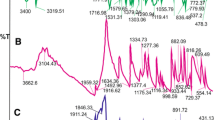Abstract
Purpose
The prevalence of rheumatic disease patients was estimated at 25% of the population. Rheumatic diseases are the leading cause of disability. The main objective of the study was to investigate the kinetic drug release characteristics of aceclofenac sustained-release (SR) matrix tablets for the management of rheumatic diseases.
Methods
The novel formulation of aceclofenac was prepared by using hydrophilic polymers such as HPMC K4M with a fixed concentration along with the varying concentration of Carbopol 946 and cationic guar gum in the formulation FA1–FA3 and FB1–FB3 respectively. The powder mixture was compressed by the direct compression method into tablets using a rotary tablet compression machine. Prepared SR matrix tablets were evaluated for uniformity of content, hardness, thickness, weight variation, friability, and in vitro dissolution studies.
Results
The drug content, hardness, thickness, weight variation, and friability of prepared tablets were found to be within the acceptable range. The optimized formulation was subjected to various kinetic release studies such as first-order model, zero-order model, Higuchi model, and Korsmeyer-Peppas model. When the data were plotted according to the Higuchi model, the formulations showed the best linearity, with regression values 0.9248 and diffusion mechanism of the formulation FB1 follows super case II transport mechanism.
Conclusion
The optimized formulation FB1 with the super case II transport mechanism prolonged the drug release, due to the polyionic interaction between the polymers. It could be an ideal formulation for the management of rheumatic diseases.






Similar content being viewed by others
References
https://www.rheumatology.org/Learning-Center/Statistics/Prevalence-Statistics. - Google Search [Internet]. Accessed 11 Mar 2020.
Lee VH, Robinson JR. Sustained and controlled release drug delivery system. New York: Marcel Dekker. p. 71–121. 138–1718
Thakur G, Singh A, Singh I. Chitosan-Montmorillonite polymer composites: formulation and evaluation of sustained release tablets of aceclofenac. Sci Pharm. 2016;84:603–18.
India, Indian Pharmacopoeia Commission, editor. Indian pharmacopoeia, 2007. 5th ed. Ghaziabad: Indian Pharmacopoeia Commission; 2007.
Abidin L, Mujeeb M, Imam SS, Aqil M, Khurana D. Enhanced transdermal delivery of luteolin via non-ionic surfactant-based vesicle: quality evaluation and anti-arthritic assessment. Drug Deliv. 2016;23:1069–74.
Jamal M, Imam SS, Mohd A, Mohd A, Mir SR, Mohd M. Transdermal potential and anti-arthritic efficacy of ursolic acid from niosomal gel systems. Int Immunopharmacol. 2015;29:361–9.
Santanu G, Barik BB. Preparation and evaluation of aceclofenac sustained release formulation and comparison of formulated and marketed product. Int J Med Med Sci. 2009;1(9):375–38.
Moon Y-W, Kang S-B, Kim T-K, Lee M-C. Efficacy and safety of aceclofenac controlled release in patients with knee osteoarthritis: a 4-week, multicenter, randomized, comparative clinical study. Knee Surg Relat Res. 2014;26:33–42.
Majid KG. Studies on drug release kinetics from ibuprofen–carbomer hydrophilic matrix tablets: influence of co-excipients on release rate of the drug. J Control Release. 1999;57:197–203.
Reddy KR, Mutalik S, Reddy S. Once-daily sustained-release matrix tablets of nicorandil: formulation and in vitro evaluation. AAPS PharmSciTech. 2003;4:480–8.
Huang Y, Yu H, Xiao C. pH-sensitive cationic guar gum/poly (acrylic acid) polyelectrolyte hydrogels: swelling and in vitro drug release. Carbohydr Polym. 2007;69:774–83.
Jay JP, Mandar K, Nirmal KP. Guar gum: a versatile material for pharmaceutical industries. Int J Pharm Pharm Sci. 2014;6(8):13–9.
Elkhodairy KA, Elsaghir HA, Al-Subayiel AM. Formulation of indomethacin colon targeted delivery systems using polysaccharides as carriers by applying liquisolid technique. Biomed Res Int. 2014;2014:1–17.
Trang TTT, Mariatti M, Badrul HY, Masakazu K, Nguyen XTT, Zuratul AAH. Drug release profile study of gentamicin encapsulated poly(lactic acid) microspheres for drug delivery. Materials Today: Proceedings 2019;17:836–45.
Higuchi T. Rate of release of medicaments from ointment bases containing drugs in suspension. J Pharm Sci. 1961;50:874–5.
Oladiran GS, Batchelor HK. Determination of flurbiprofen solubility in a wax-based matrix using hyperdsc, Higuchi release kinetics and microscopy. Chem Eng Res Des. 2007;85(7):1039–43.
Siepmann J, Peppas NA. Mathematical modeling of controlled drug delivery. Adv Drug Deliv Rev. 2001;48:137–8.
Fu Y, Kao WJ. Drug release kinetics and transport mechanisms of non-degradable and degradable polymeric delivery systems. Expert Opin Drug Deliv. 2010;7:429–44.
Varma MVS, Kaushal AM, Garg A, Garg S. Factors affecting mechanism and kinetics of drug release from matrix-based oral controlled drug delivery systems. The American J Drug Deliv. 2004;2(1):43–57.
Huanbutta K, Sangnim T. Design and development of zero-order drug release gastroretentive floating tablets fabricated by 3D printing technology. J Drug Deliv Sci Tec. 2019;52:831–7.
Author information
Authors and Affiliations
Corresponding authors
Ethics declarations
The current work does not involve any animals and humans.
Conflict of Interest
The authors declare that they have no conflict of interest.
Additional information
Publisher’s Note
Springer Nature remains neutral with regard to jurisdictional claims in published maps and institutional affiliations.
Rights and permissions
About this article
Cite this article
Karthikeyan, M., Deepa, M.K., Bassim, E. et al. Investigation of Kinetic Drug Release Characteristics and In Vitro Evaluation of Sustained-Release Matrix Tablets of a Selective COX-2 Inhibitor for Rheumatic Diseases. J Pharm Innov 16, 551–557 (2021). https://doi.org/10.1007/s12247-020-09459-9
Published:
Issue Date:
DOI: https://doi.org/10.1007/s12247-020-09459-9




